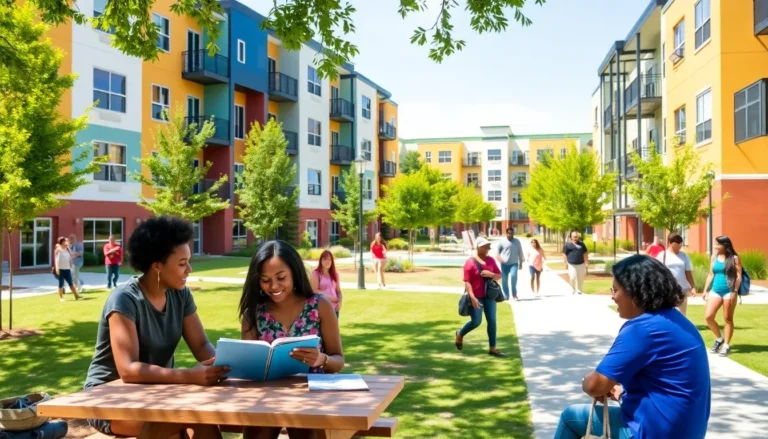Table of Contents
ToggleIn the wild world of academia, student motivation often feels like a mythical creature—everyone talks about it, but few have actually seen it. Picture this: students staring blankly at their textbooks, as if they’re deciphering ancient hieroglyphics. The struggle is real, and it’s time to tackle it head-on.
Understanding Student Motivation
Understanding student motivation involves recognizing what drives them to engage with their learning process. It requires insight into the emotional, cognitive, and social factors that enhance or inhibit their motivation.
Definition of Student Motivation
Student motivation refers to the internal and external factors that stimulate students to learn. Intrinsic motivation derives from personal interests or goals, while extrinsic motivation involves external rewards like grades or praise. Both types play critical roles in educational success. Motivated students demonstrate higher levels of persistence, engagement, and academic achievement.
Factors Influencing Student Motivation
Multiple factors influence student motivation, creating a complex landscape. Personal interest in subjects significantly enhances engagement. Goal-setting also drives motivation, as clear objectives give students direction in their studies. Social environment matters, too; supportive peers and teachers foster a positive learning atmosphere. Additionally, student autonomy impacts motivation, as choices encourage ownership over their education. External rewards like grades provide further incentives, enhancing motivation levels. Understanding these factors can bolster strategies for improving student motivation in academic settings.
Theories of Student Motivation

Theories of student motivation provide insights into how to foster engagement in educational settings. Understanding various motivational theories can help educators develop effective strategies.
Intrinsic vs. Extrinsic Motivation
Intrinsic motivation stems from personal interest and enjoyment of the learning material. For example, a student fascinated by science engages deeply in experiments and research. Conversely, extrinsic motivation relies on external rewards like grades and praise. Many students put in effort to achieve high scores on assignments. Both types of motivation significantly impact student involvement, and combining them can yield positive results.
Maslow’s Hierarchy of Needs in Education
Maslow’s Hierarchy of Needs outlines the fundamental needs that drive human behavior, applicable to educational environments. At the base, physiological needs like food and shelter must be met for students to focus on learning. Safety needs follow, encompassing emotional and academic security. Social belonging also plays a crucial role, as supportive relationships with peers and teachers enhance motivation. On a higher level, esteem needs involve recognition and respect, propelling students toward self-actualization through achieving their full potential. Understanding this hierarchy helps educators address the varied needs of their students to foster motivation effectively.
Strategies to Enhance Student Motivation
Enhancing student motivation requires targeted strategies that address various aspects of the educational experience. Below are key approaches to consider.
Creating a Supportive Learning Environment
A supportive learning environment cultivates motivation and engagement. Students thrive in spaces where they feel safe and respected. Building positive relationships between teachers and students fosters trust and openness. Regular feedback encourages students to improve while acknowledging their efforts. Collaboration among peers promotes a sense of belonging and motivates students to participate actively. Establishing clear expectations helps students understand what is required of them, which contributes to confidence and accountability. Such an atmosphere nurtures intrinsic motivation by allowing students to explore their interests freely.
Engaging Curriculum Design
An engaging curriculum design captivates students’ attention and fuels their desire to learn. Incorporating real-world applications into lessons provides context and relevance, sparking interest. Offering choices within assignments empowers students, making them feel involved in their education. Varied instructional methods, such as group projects, discussions, and hands-on activities, cater to diverse learning styles. Including technology in the classroom can enhance engagement, providing interactive and dynamic learning experiences. Setting challenging yet attainable goals motivates students to strive for success while celebrating their achievements along the way.
The Role of Teachers and Parents
Teachers and parents play pivotal roles in cultivating student motivation. Their collaborative efforts significantly influence a student’s academic engagement and success.
Teacher Techniques for Fostering Motivation
Effective teacher techniques include setting clear expectations for students. Tailoring lessons to student interests enhances relevance and engagement. Emphasizing collaboration through group activities fosters a sense of belonging. Providing timely feedback helps students recognize their progress. Incorporating a variety of teaching methods keeps lessons dynamic. Celebrating milestones encourages students to strive for continuous improvement. Using real-world applications makes lessons more meaningful and practical.
Parental Involvement and Its Impact
Parental involvement directly correlates with student motivation. Active engagement in a child’s education fosters a supportive learning environment at home. Open communication between parents and teachers allows for consistent reinforcement of academic goals. Encouraging healthy study habits strengthens students’ self-discipline. Providing resources like books or educational tools enriches learning opportunities. Celebrating academic achievements instills confidence, motivating students to pursue further successes. When parents model a positive attitude toward education, children often develop similar views on learning.
Addressing student motivation is essential for fostering a productive learning environment. By understanding the intricate balance between intrinsic and extrinsic factors educators can create strategies that resonate with students. A supportive atmosphere coupled with engaging curricula can significantly enhance motivation levels.
Teachers and parents play crucial roles in this journey. Their involvement not only fosters a sense of belonging but also encourages students to take ownership of their learning. By prioritizing these elements, the educational community can work together to inspire students to reach their full potential. Ultimately, a motivated student is more likely to thrive academically and develop a lifelong love for learning.







